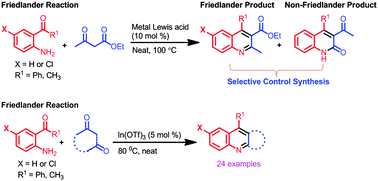The scope and limitations of metal salt Lewis acid catalysts were examined for the selectivity control for the formation of Friedländer and non-Friedländer products during the reaction involving 2-aminobenzophenone and ethyl acetoacetate. Among a pool of metal halides, tetrafluoroborates, perchlorates, and triflates used as catalysts, In(OTf)3 emerged as the most effective catalyst for the selective/exclusive formation of the Friedländer product. The generality of the In(OTf)3-catalysed Friedländer reaction was demonstrated by the reaction of differently substituted 2-aminoarylketones with various carbonyl compounds containing an active methylene group (e.g., β-ketoesters, cyclic/acyclic β-diketones, cyclic/acylic ketones, and aryl/heteroaryl methyl ketones) under solvent-free conditions affording the desired quinolines in 75–92% yields.

